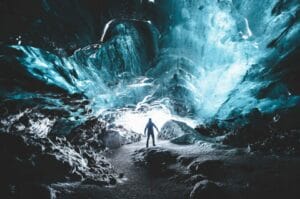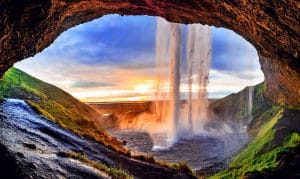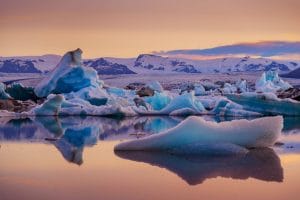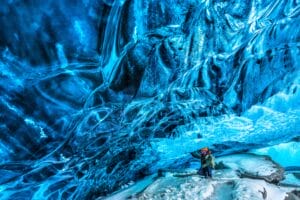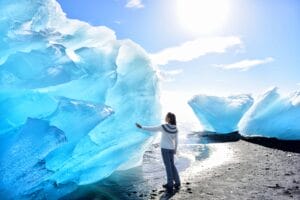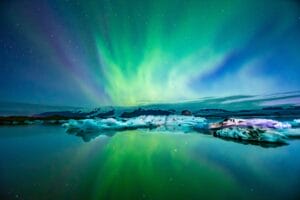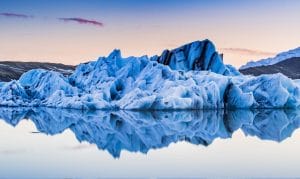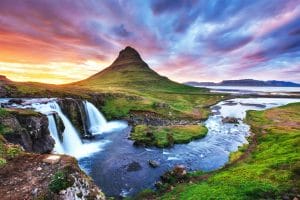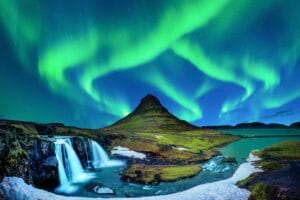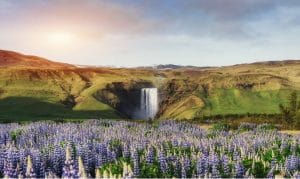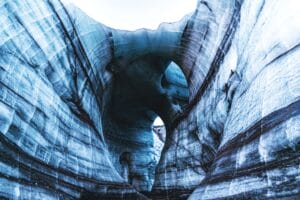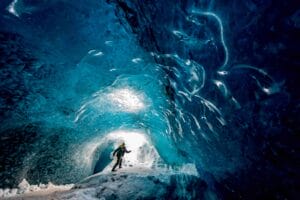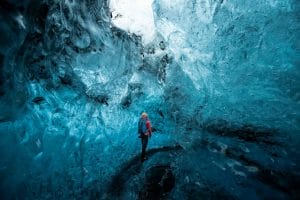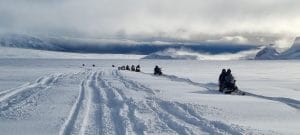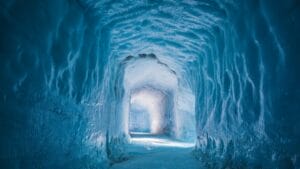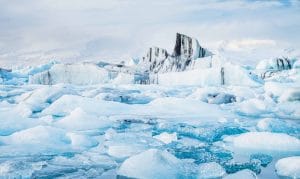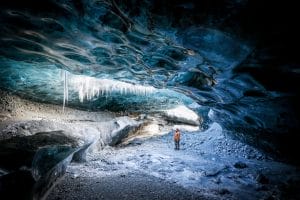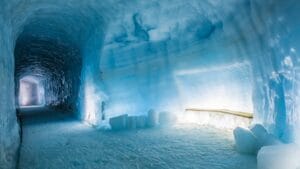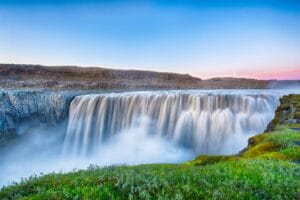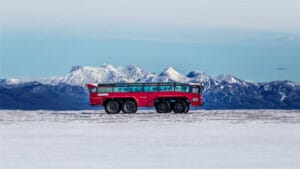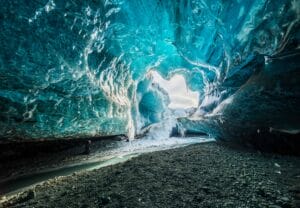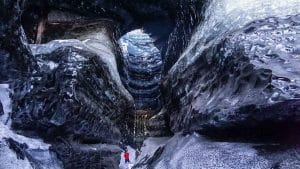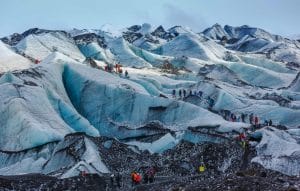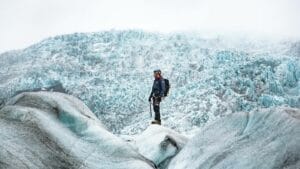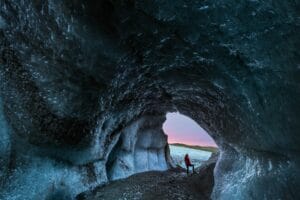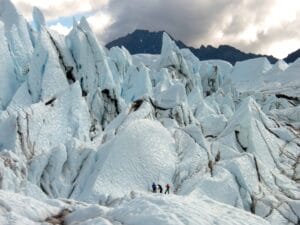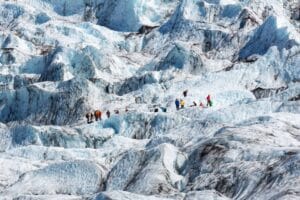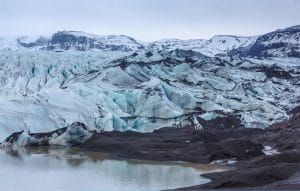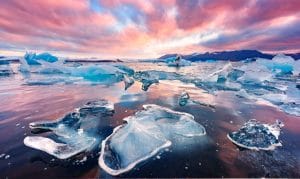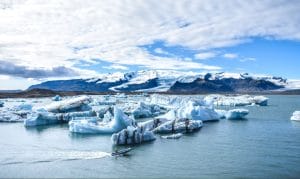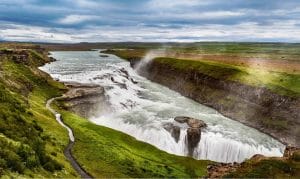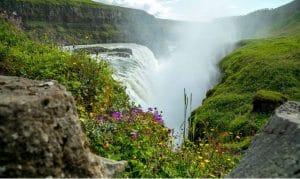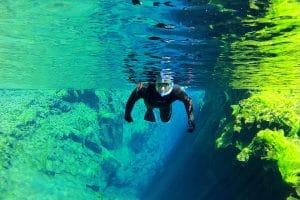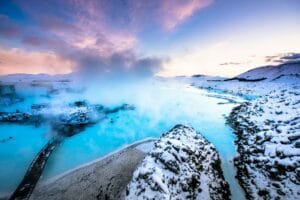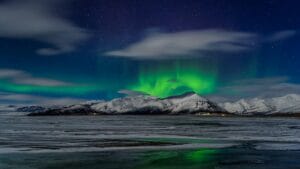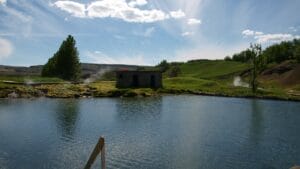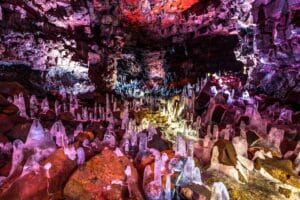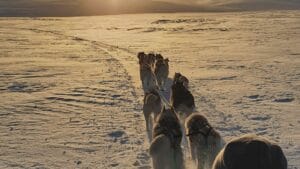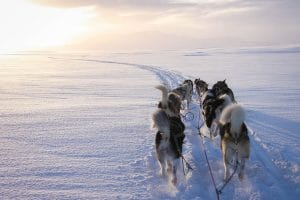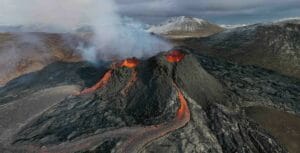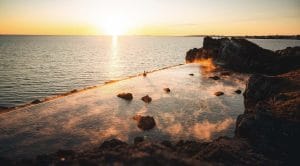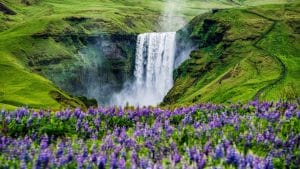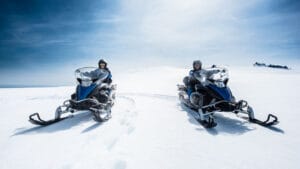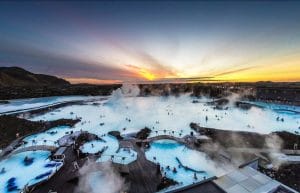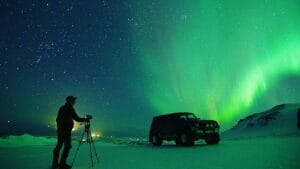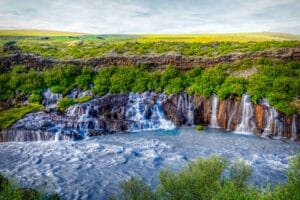Winters are challenging in the far north. But, November in Iceland is such a delightful time of the year despite being cold. By November, the country is in full swing; the temperatures dropping, sweeping winds, bouts of sunshine make for a fantastic time to visit Iceland in November. From Northern Lights to ice caves, snowmobiling to Silfra snorkeling, music festivals to Icelandic language holiday and book fairs, there’s an abundance of adventure and culture the country has to offer.
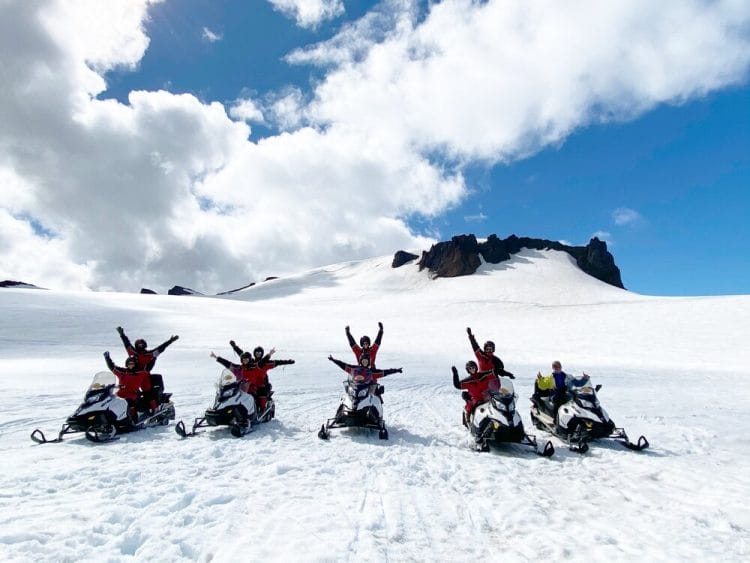
Iceland Weather in November
Without any surprises, Iceland in November isn’t actually so cold expecting the far north country is. November in Iceland can range between warm and dry to cold and wet to absolutely freezing and snowy. The Icelandic winter is on its way in November. The country is truly a land of unpredictable weather, however, November is a stable winter month that makes for a perfect time for a winter vacation to Iceland.
Temperature
The average temperature in Iceland in November hovers between 1°C-8°C (33°F-46°F), gaging even lower in the Icelandic highlands at high altitudes. The temperature is pretty steady throughout the month.
Precipitation
You can expect good rainfall in November. There’s an average of 80mm (3 inches) of precipitation, and about 10 days of rainfall in the form of sleet or snow. There’re about 42% chances of snowfall. Though, snow accumulation around this time is unlikely. Wind speeds also pick up at about 24 mph. The precipitation in November is the first stage of the season’s ice sculptures, it happens to naturally decorate the ice caves and glaciers.
Daylight Hours
During this time of the year, the amount of sunlight decreases. There aren’t many daylight hours during November. Towards the end of the month, the days see only 5 hours of sunlight. After mid-November, you can expect sunrise at 10:00 am and sunset at 4:00 pm.

Pros of Visiting Iceland in November
1. Northern Lights
- Pro: November is one of the best months to see the Northern Lights in Iceland. The long, dark nights provide the perfect conditions for spotting the aurora borealis, and many guided tours offer Northern Lights excursions. With a bit of luck and clear skies, you have a great chance of witnessing this natural phenomenon.
2. Fewer Tourists
- Pro: November falls in the off-season, which means fewer tourists compared to the summer months. Popular attractions like the Golden Circle, Reykjavik, and waterfalls are much less crowded, giving you more space to explore at your own pace.
3. Lower Prices
- Pro: As it’s the off-season, flights, accommodations, and car rentals are often more affordable in November. You can find some great deals and save money on your trip. Many tours also offer lower prices, making it a budget-friendly time to visit Iceland.
4. Access to Ice Caves
- Pro: November marks the beginning of ice cave season in Iceland. The famous blue ice caves under Vatnajökull glacier become accessible, offering a once-in-a-lifetime experience to explore the natural wonders inside these stunning formations. Ice cave tours are popular, and November is the start of the best time to visit them.
5. Snow-Covered Landscapes
- Pro: By November, many parts of Iceland begin to see snow, transforming the landscapes into a winter wonderland. The contrast between the snow-covered mountains, black sand beaches, and steaming geothermal areas is breathtaking. This is a great time for photographers seeking unique shots of Iceland’s iconic sights in winter conditions.
6. Holiday Season Vibes
- Pro: In late November, you’ll start to see Icelandic towns, especially Reykjavik, getting into the holiday spirit. Christmas lights begin to go up, and seasonal markets pop up, creating a cozy and festive atmosphere. The Iceland Airwaves Festival also usually happens in early November, showcasing music from Icelandic and international artists.
Cons of Visiting Iceland in November
1. Unpredictable Weather
- Con: November is known for its unpredictable weather in Iceland. You can experience rain, snow, wind, and freezing temperatures all in one day. The weather can sometimes make driving and outdoor activities challenging, so it’s important to be prepared for sudden changes and have flexible plans.
2. Shorter Daylight Hours
- Con: By November, Iceland’s days are getting shorter, with only 5-6 hours of daylight by the end of the month. This means you’ll need to plan your activities around the limited daylight hours, especially if you want to take road trips or explore outdoor attractions. However, the longer nights make for better Northern Lights viewing.
3. Some Roads and Highland Areas Are Inaccessible
- Con: Many of Iceland’s highland roads (F-roads) and remote areas, like Landmannalaugar and some parts of Þórsmörk, become inaccessible due to snow and ice. If your itinerary includes hiking or visiting Iceland’s interior, November may not be the best time. However, there are still plenty of accessible attractions along the Ring Road and in the south and west.
4. Icy and Slippery Conditions
- Con: As temperatures drop, roads and walking paths can become icy and slippery in November, especially in the mornings and evenings. If you’re renting a car, it’s important to have winter tires and be cautious when driving. For those exploring on foot, proper footwear with good grip is essential to avoid slips.
5. Limited Outdoor Activities
- Con: Some outdoor activities, like hiking, may be limited in November due to weather conditions and shorter daylight hours. While many popular tours are still running, it’s important to check the availability and weather conditions in advance. For more adventurous activities like river rafting or camping, November isn’t ideal.
6. Colder Temperatures
- Con: Temperatures in November can range from -1°C to 5°C (30°F to 41°F), and with the wind chill, it can feel even colder. For travelers who are sensitive to cold weather, this might be a downside, but with proper winter clothing, the cold is manageable.
What to Do in Iceland in November – A Guide to Winter Adventures
November marks the beginning of winter in Iceland, offering a unique mix of activities that blend the magic of the cold season with the country’s iconic natural wonders. From chasing the Northern Lights to exploring ice caves and soaking in hot springs, Iceland in November offers unforgettable experiences with fewer crowds and a true winter wonderland vibe. Whether you’re a first-time visitor or returning for a new adventure, here’s a guide to the best things to do in Iceland in November.
1. Hunt for the Northern Lights

November is one of the best months to see the Northern Lights (Aurora Borealis). The nights are long and dark, providing optimal conditions for spotting this natural wonder. With the right combination of clear skies and solar activity, you’ll have a great chance to witness the breathtaking display of green, pink, and purple lights dancing across the sky.
- Where to see the Northern Lights: For the best viewing, head to areas with little to no light pollution, such as Thingvellir National Park, Vik, or Reykjanes Peninsula. Many guided Northern Lights tours take you to the best spots for Northern Lights hunting, and experienced guides will know how to maximize your chances of seeing the aurora.
- Tip: Use apps like My Aurora Forecast to track the aurora’s activity and get real-time updates on the likelihood of seeing the lights.
2. Explore Ice Caves
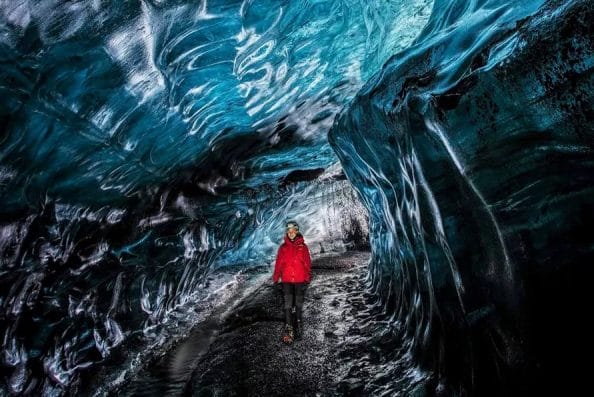
November marks the start of ice cave season in Iceland, and exploring these natural wonders is an absolute must. The blue ice caves formed within glaciers, particularly under Vatnajökull, the largest glacier in Europe, offer a surreal experience. Walking through these translucent blue chambers is like stepping into another world, with their intricate ice formations and stunning shades of blue.
Where to explore ice caves: The most popular ice caves are located under the Vatnajökull Glacier in South Iceland. Many guided tours depart from Jökulsárlón Glacier Lagoon or Höfn, and it’s essential to go with an experienced guide for safety reasons. Another option is to go for Katla Ice Cave – the only natural ice cave that is safely accessible all year. The tour departs from Vík in South Iceland.
Tip: Most Ice caves are accessible only in the colder months (November through March), so booking a tour in advance is highly recommended. For a summer tour, Katla Ice Cave is the only natural ice cave available.
3. Relax in Geothermal Hot Springs

As temperatures drop, there’s nothing quite like soaking in one of Iceland’s famous geothermal hot springs. November is the perfect time to unwind in these naturally heated pools while surrounded by snowy landscapes. Iceland’s hot springs offer a peaceful escape, whether you’re looking for a luxury spa experience or a more natural, rugged setting.
Top hot springs to visit:
- Blue Lagoon: A world-famous geothermal spa, the Blue Lagoon offers a luxurious soak in mineral-rich, milky blue waters. With fewer tourists in November, you can enjoy a more tranquil experience.
- Sky Lagoon: Located just outside Reykjavik, the Sky Lagoon offers breathtaking views of the Atlantic Ocean while you relax in its geothermal waters. Its unique 7-step ritual combines Icelandic spa traditions with modern wellness.
- Secret Lagoon: For a more rustic experience, head to the Secret Lagoon near the Golden Circle. This natural hot spring is surrounded by steaming geysers and offers a more laid-back, less commercialized experience.
- Reykjadalur Hot Springs: If you’re up for a short hike, the Reykjadalur valley offers a rewarding soak in a natural hot river, just a 45-minute hike from Hveragerði.
- Hvammsvik Hot Spring is a natural pool with breathtaking views. Located just 40 minutes from Reykjavik.
Tip: Bring a swimsuit, towel, and flip-flops when visiting hot springs, and be prepared for chilly temperatures when getting in and out of the water.
4. Take a Glacier Hike

November is a fantastic time to experience one of Iceland’s glacier hikes. With the arrival of winter, the glaciers become even more awe-inspiring, and walking across the ice offers a chance to explore crevasses, ice ridges, and snow-covered peaks. Glacier hiking is available in places like Sólheimajökull and Vatnajökull, where experienced guides will take you safely onto the glacier with crampons and ice axes.
Where to go glacier hiking:
- Sólheimajökull Glacier: Located near Vik on Iceland’s south coast, Sólheimajökull offers accessible glacier hikes and can easily be combined with a visit to nearby attractions like Skógafoss and Reynisfjara.
- Skaftafell in Vatnajökull National Park: Another popular spot for glacier hiking, Skaftafell is part of Vatnajökull National Park and offers spectacular views of the surrounding landscapes.
Tip: Glacier hikes can range from a few hours to a full day, so choose a tour that matches your fitness level and interest.
5. Drive the Golden Circle
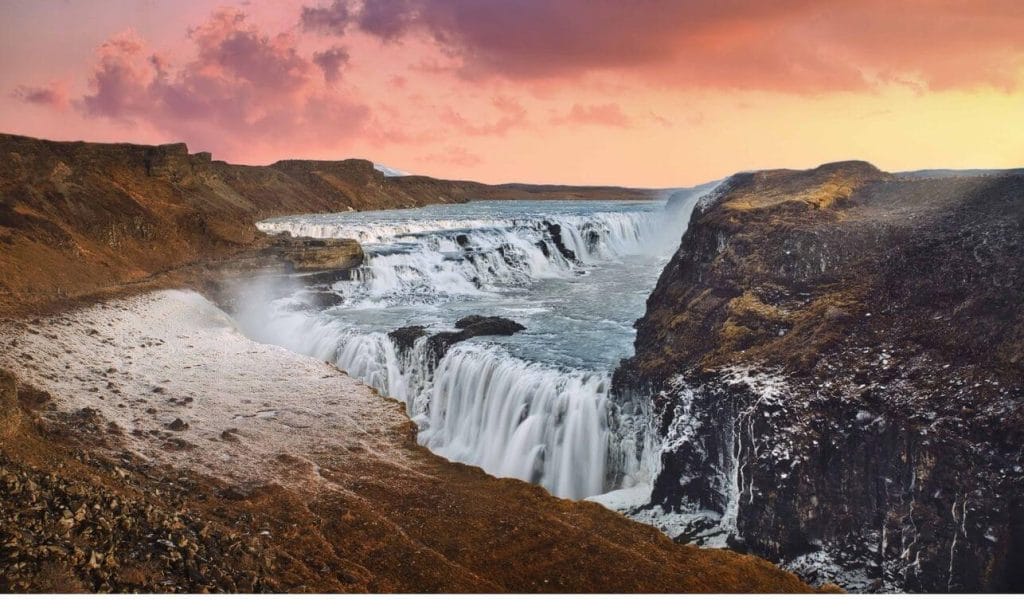
The Golden Circle is one of Iceland’s most popular sightseeing routes, and it’s just as magical in November. The route takes you through three major attractions: Thingvellir National Park, Geysir Geothermal Area, and Gullfoss Waterfall. The snow-dusted landscapes and frosty mornings add a whole new dimension to these iconic sights.
Thingvellir National Park: A UNESCO World Heritage Site where the North American and Eurasian tectonic plates meet. In November, the park’s clear skies are ideal for Northern Lights viewing.
Geysir Geothermal Area: Watch as Strokkur, one of Iceland’s most active geysers, erupts every few minutes, shooting water up to 20 meters (65 feet) into the air.
Gullfoss Waterfall: This two-tiered waterfall is breathtaking year-round, but in November, you might see it partially frozen, creating an ethereal winter scene.
Tip: Roads in Iceland can be icy in November, so drive carefully, and make sure your rental car is equipped with winter tires. Another option to explore the Golden Circle in November is to take a guided tour.
6. Visit Reykjavik and Enjoy the Holiday Season Vibes
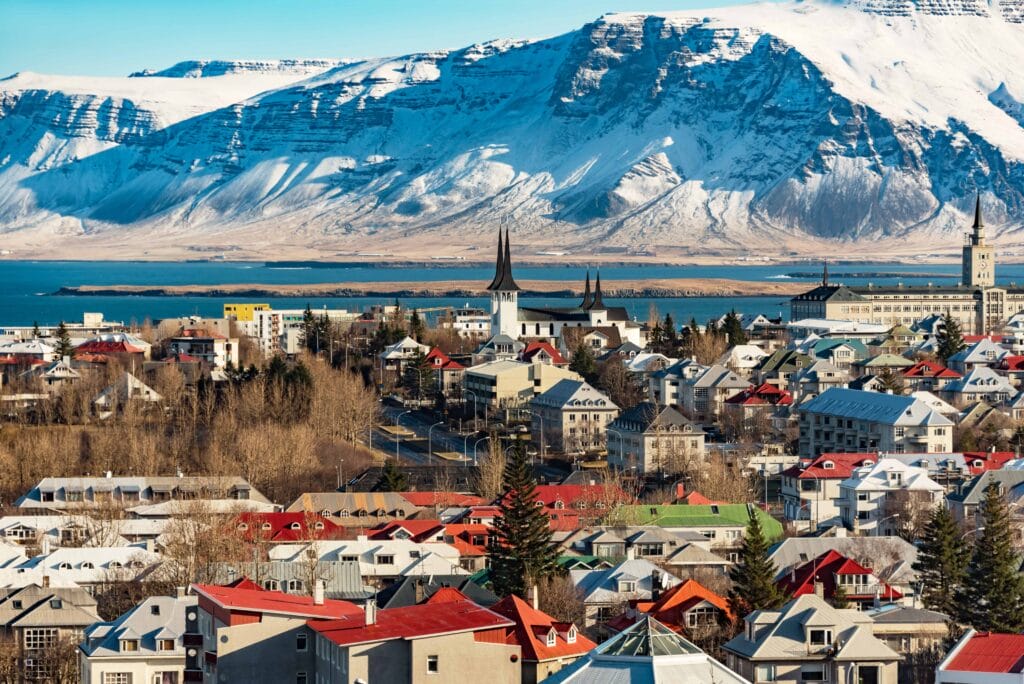
November is when Reykjavik starts to transition into the holiday season. The streets are decorated with festive lights, cozy cafés offer warming drinks, and the city becomes a hub of culture and events. Take a stroll down Laugavegur Street, visit one of the city’s many museums, or head to the Old Harbour to take in the views.
Iceland Airwaves Festival: If you’re visiting in early November, you’ll have the chance to attend the Iceland Airwaves Festival, one of the country’s most famous music events. This festival features Icelandic and international artists performing across multiple venues in Reykjavik.
Tip: The Christmas markets and festive lights in Reykjavik begin popping up in late November, adding a magical winter atmosphere to your city experience.
7. Visit Jökulsárlón Glacier Lagoon and Diamond Beach

Jökulsárlón Glacier Lagoon, located in South Iceland, is a must-visit year-round, but in November, it’s especially enchanting. As the nearby Breiðamerkurjökull Glacier calves icebergs into the lagoon, they slowly drift towards the ocean, creating a mesmerizing scene. Just across the road, Diamond Beach is where these icebergs wash ashore, sparkling like diamonds against the black sand.
- Tip: Early morning visits can give you the lagoon and beach almost to yourself, and the low winter light creates stunning photography opportunities.
8. Explore Snæfellsnes Peninsula

For those looking to escape the more popular tourist areas, the Snæfellsnes Peninsula is a great option. This region is home to Snæfellsjökull National Park, Kirkjufell Mountain, and rugged coastal cliffs. November’s snowy landscapes and stormy seas make the area even more dramatic and photogenic.
Kirkjufell Mountain: Known as Iceland’s most photographed mountain, Kirkjufell is especially beautiful in November, with its snow-capped peak reflecting in nearby lakes.
Snæfellsjökull Glacier: Explore this dormant volcano topped with a glacier, made famous by Jules Verne’s “Journey to the Center of the Earth.”
Tip: Plan your drive carefully, as weather conditions can change rapidly on the peninsula.
9. Dogsledding
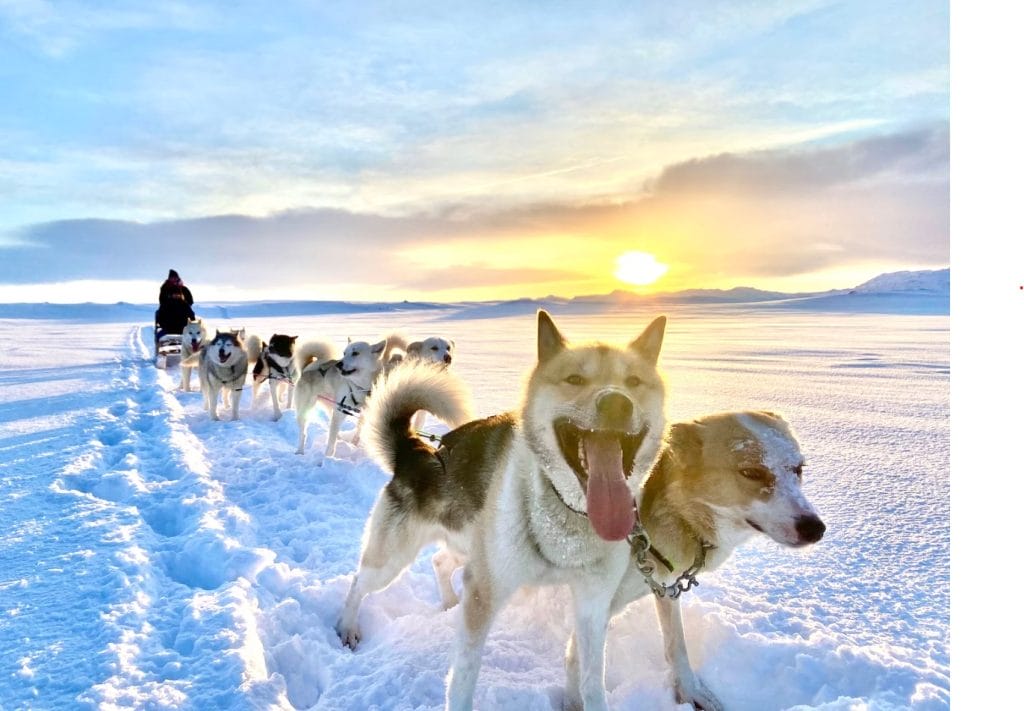
Experience the thrill of gliding across Iceland’s winter landscapes by joining a dog sledding tour. November’s snow-covered fields create the perfect setting for this exhilarating activity. While dog sledding is commonly associated with Arctic regions, Iceland’s unique terrain and trained huskies make it an unforgettable experience. You can mush your own team of dogs or simply enjoy the ride while the experts guide the sled.
- Where to go dog sledding: Dog sledding tours are available from near Reykjavik, Myvatn and Akureyri. Some tours operate on snowy fields or glaciers, offering stunning views of Iceland’s winter wilderness.
- Tip: Be sure to dress warmly with layers, as the wind chill can make it colder while sledding. Many tours also allow for interaction with the huskies, so prepare for some extra fun time with the friendly dogs!

Exploring the Culture: Things to Do around Iceland in November
Christmas Shopping
Iceland is packed with Christmas markets and activities. During this time of the year, you can spot so many Santa Claus’ around the streets in the town. The best Icelandic outlets to shop are Geysir, Kron, Farmer’s Market, and more. Geysir is perfect for warm blankets and clothing, shoes, and scented candles. Kron is an artsy place for cool goodies while Farmers Market is perfect for some natural colored clothing. You can check the Icelandic brands Tulipop for the cutest options for kids and little ones.
Museums
Iceland serves to all cultural needs; Reykjavik is filled with interesting and quirky museums. The Reykjavik Art Museum is host to arcades of contemporary art. The exhibitions at the National Gallery of Iceland and the Icelandic Phallological Museum are always intriguing.
Explore Café Culture
They say that an average Icelander, the keen coffee drinker, drinks around 9kg coffee beans per year. The coffee culture in Iceland is tailored and community-driven. You could also find free coffee in most local markets. They also have some of the high-quality roasted coffee found in the world. Iceland is filled with top-notch cafes in every street. There are many cozy cafes like Reykjavik Roasters, Te & Kaffi, Kaffitár, and Café Babalú that offer free refills allowing the guests to immerse in the artistic cozy city.
Food and Drink
Iceland is packed with superb bars and restaurants. You can find a lot of world class restaurants in Reykjavik that serves amazing food by top chefs. If you are not up for fine dining, one of the favorite foods in Iceland is the hot dogs. You can find the best hot dogs in the stands in the harbor area.
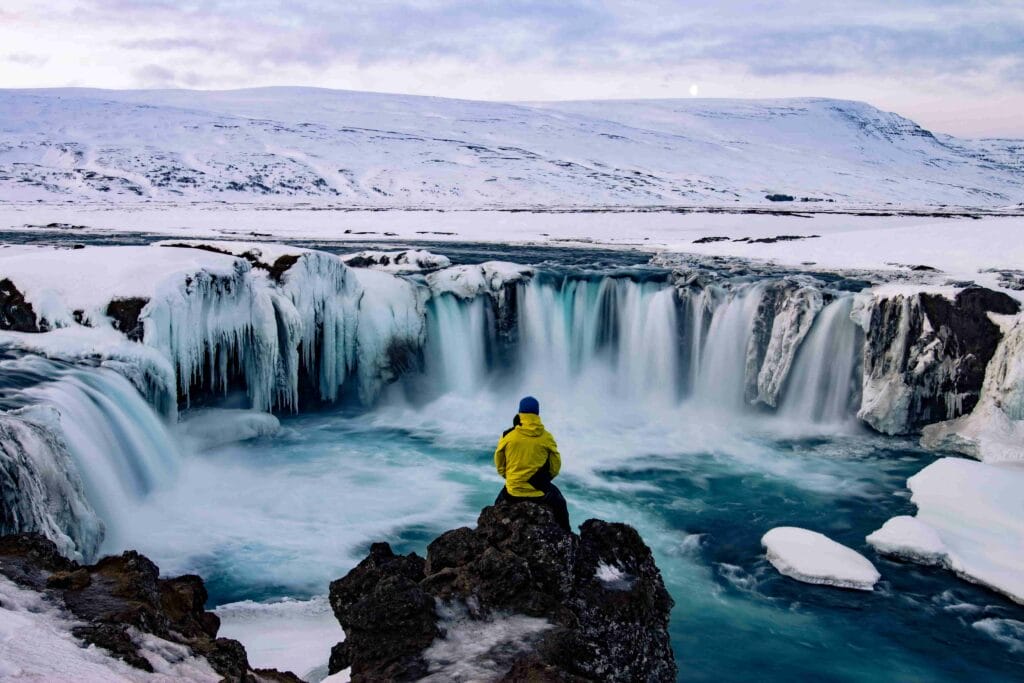
Events in Iceland during November
Iceland Airwaves
For three musical days during the first weekend of November, Iceland turns into a melody itself- Iceland Airwaves is the country’s biggest and most loved festival. The event attracts many music fans and artists, music journalists and scouts from across the world. David Fricke, the writer of Rolling Stone once mentioned that Iceland Airwaves is “the hippest long weekend on the annual music festival calendar.” Started in 1999, it has come a long way and has now become one of the premier music events known for worldly ambiance and great talent.
Icelandic Airwaves Pro
This is a new addition to the Icelandic Airwaves Festival. Welcoming the music veterans and music lovers alike, the event gives an insider look into the music industry. This is a two-day program organizing panels, presentations, and seminars.
Icelandic Language Day
Icelandic Language Day or Dagur íslenskrar tungu is celebrated on November 16th. This day is a reminiscence of the importance of the country’s unique language. It signifies preserving the remarkable language in the modern-day world. The holiday has been celebrated since 1996. On this day, Icelanders are encouraged to use Icelandic. Various cultural programs are organized in schools and Harpa Concert Hall, and the people who helped in promoting Icelandic literature are awarded.
Reykjavik Book Fair
Held during November 23-24, this is an annual literary event that honors authors published in Iceland. The fair has been organized since 2011 after Iceland joined the UNESCO Creative Cities Network. The event hosts exhibitions, discussions, readings, and story sessions for children.
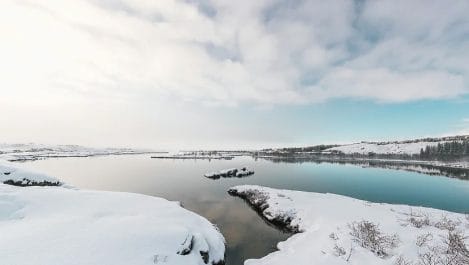
Your Packing Essentials for November in Iceland
Clothing Recommendations:
As the temperature is dropping in November and the weather is mostly unpredictable, it is important to pack a variety of clothing. And, always remember that layering is the key!
- Waterproof Trousers
- Snow Boots
- Windproof Coat
- Earmuffs
- Scarf
- Fleece Lined Hat
- Fleece Lined Thermals
- Water and Windproof Gloves
- Thermal Base Layers
- Mid-layers
- Warm Jumper
- Swimming Costume
- Quick-dry Towel
- Waterproof Snow Boots
- Approach Shoes
- Hiking Boots
- Casual Footwear
- Flip flops
Other Essentials:
- Travel Backpack
- Travel Umbrella
- Travel Pillow
- Sleep Mask
- Polarized Sunglasses
- Power Adapter
- USB-Car Charger
- Filtered Water Bottle
- Coffee Thermos
- Camera/Action Camera
- Medication
- Jet Lag Relief
- Required Documents
As called the land of fire and ice, Iceland is in its yet another unique and wondrous form in November. With dropping temperatures, chilly winds, numerous sights for landscapes, myriad of adventures, interesting events, and intriguing culture, November is an amazing time in the year to visit Iceland for every adventurer and traveler.


